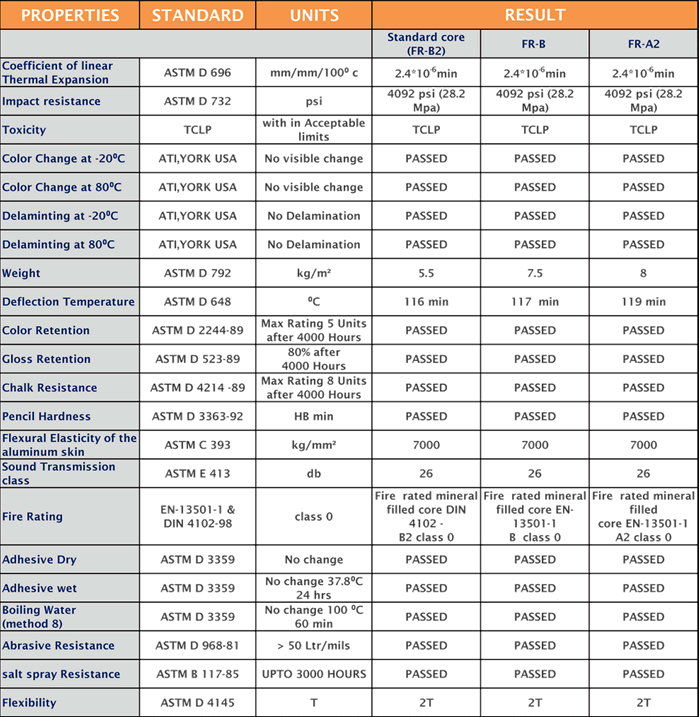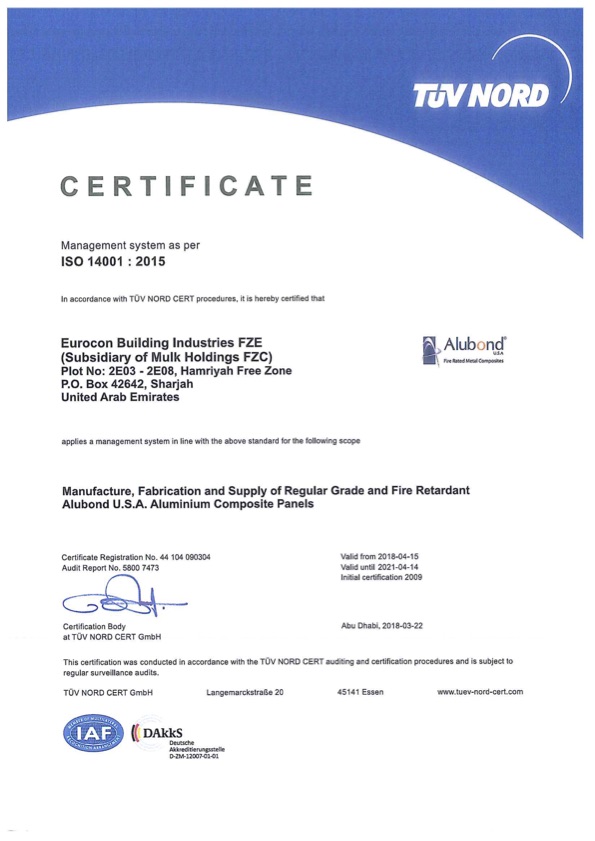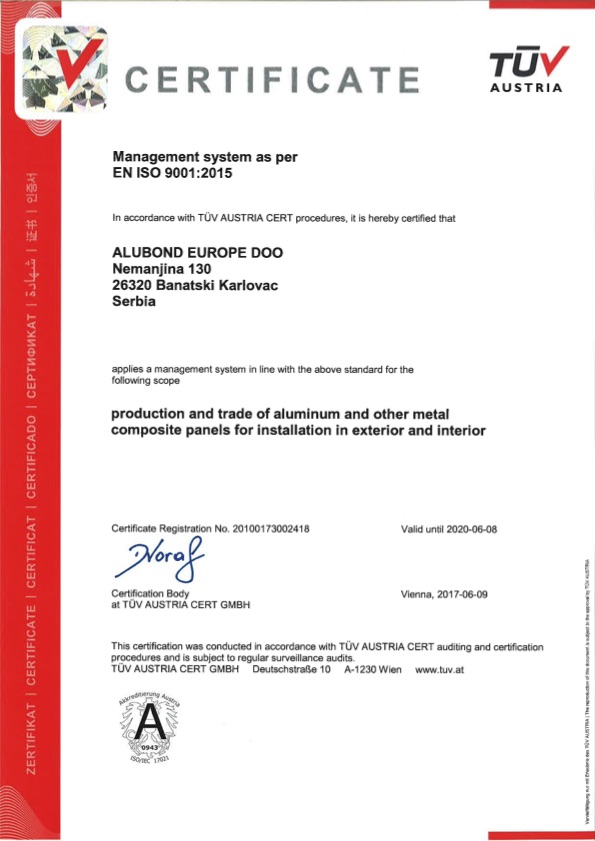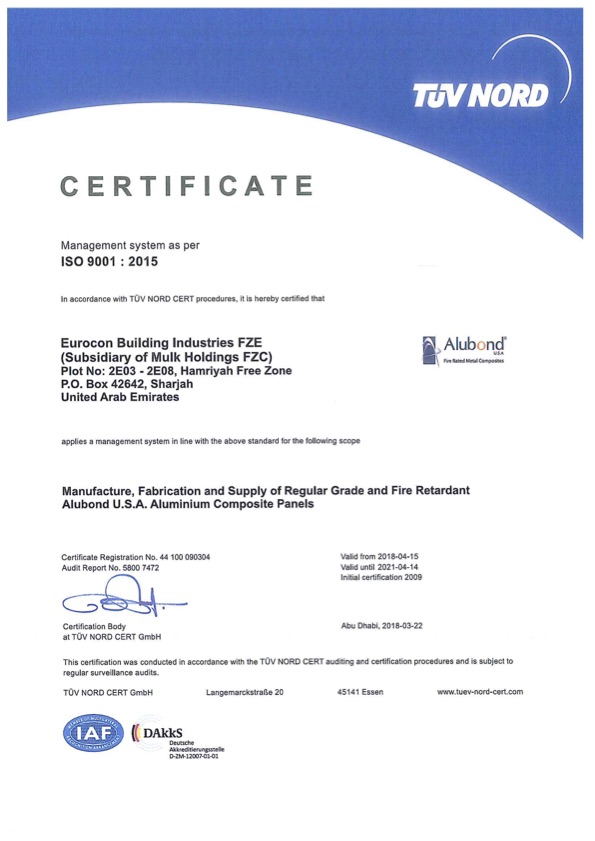CLEANING METHODS
Routine cleaning of the Alubond U.S.A ACP panel surface is recommended. It may be washed with water and mild detergent followed by a clean water rinse. The frequency of cleaning and the choice of suitable cleaning agent depend largely on the position of the building being cleaned and degree of contamination. Do not clean sun-heated surfaces (above 400 C) to avoid rapid drying which may lead to stain formation.
The cleaning operation must be followed by a thorough rinse with clean water to ensure the removal of all remnants of the cleansing agent. A final wipe down by means of a sponge, leather or wiper is necessary to avoid water stains.
The Alubond U.S.A ACP panel is resistant to industrial atmospheres and is self-cleansing in most environments. As with all claddings, improvements in durability is achieved by an annual wash down with warm water so to avoid the buildup of deposits. The Alubond U.S.A ACP panels is anti static and more
self-cleansing than many of the alternatives.
Scope
This manual is applied to the cleaning and maintenance procedures for the external cladding of the Alubond U.S.A ACP panels on which Stove Lacquered – based Fluorocarbon (PVDF), Polyester, and Acrylic paints are coated.
Purposee
The purpose of this chapter is to assist project people such as architects, contractors, building owners, et al., who are concerned with and / or engaged in the cleaning and maintenance of the external cladding of the Alubond U.S.A ACP panels, especially in establishing safe and sound cleaning procedures.
General Notes
Not only Stove Lacquered – based fluorocarbon coating but also precolor, polyester acrylic resin or normal organic coatings onto aluminum will not show an appreciable amount of dirt collection; however the dirt and soil depends largely on the local atmospheric conditions where the building exists. In heavily industrialized area, coastal areas and the areas where construction works are being carried out, it might be necessary to increase the cleaning frequency, not only for the sake of appearance but also for the purpose of removing the dirt and soil likely to be detrimental to the coating surface.
Very often, rainfall is effective to remove dirt and to keep the external cladding clean. In areas of low rainfall, this effect may not be expected and accordingly the cleaning frequency might be increased. Even in the same building, portions which are in direct sight at lower levels might be cleaned more frequently, and less obvious portions might be cleaned less frequently or in some instances hardly at all. And in these areas, detrimental
components might be deposited on the coated surface. These factors would determine the cleaning schedule.
In planning the actual cleaning schedule of the external cladding, the schedule might be adjusted with other cleaning operations for glass and painted aluminum components.
Cleaning Frequency
Cleaning is required more often in the following areas in general:
Areas Of Low Rainfall
– Heavily industrialized areas
– The areas where construction works are being carried out
– Foggy coastal regions with frequent cycles of condensation and dryness.
In foggy and coastal regions, frequent cycles of condensation and dryness take place and salty components and dirt tends to deposit. Especially, sheltered areas such as overhangs may be soiled easily because of lack of washing by rain.
Machine Cleaning
Once automatic wall cleaning machine is considered to be used, a pre-test should be done in the early stage of equipment design to confirm that there is no detrimental effect on the coating as well as to clarify the cleaning effect and frequency.
Cleaning Procedures
After project completion, construction soils including concrete or mortar etc., should be removed as quickly as possible. In most cases, the following suggested frequency would be required to keep the coated surface clean as good as it can remain.

Soil Removal
The simplest procedure would be water rinse with moderate pressure to remove the soil. If this does not remove the soil, then a concurrent water spray with sponge should be tested. If the soil is still adhering after drying, then a mild detergent or 5 – 10% IPA (Isopropyl Alcohol) solution will be necessary.
In order to remove light soil, it is recommended to do some tests to determine the degree of cleaning actually necessary to accomplish the task. Prior to any cleaner application, a forceful water rinse from top to down is recommended as an initial step of tests. The lower water volume with moderate pressure is much better than the considerable water volume with little pressure. When cleaner is applied, physical rubbing with soft sponges or soft rags fully dipped into the liquid solution is also helpful.
Clean Detergents / Solutions
When a mild detergent or 5 – 10% IPA solution is used for removing soil, it should be used with soft sponges and / or soft rags. The washing should be done with uniform pressure, and normally the operation is done with a horizontal motion first and then with a vertical motion. After washing, the surface should be thoroughly rinsed with clean water, and the rinsed surface is air-dried or wiped with chamois, squeegee or lint-free cloth.
Operation Sequence
Dripping of cleaner to the lower portions of the building should be minimized. When some rundown is unavoidable, the areas should be rinsed as soon as possible, to eliminate streaking. Generally, the clean and rinse operations move from top to bottom of the building.
Avoid drips and splashes during cleaning. Remove dripping as quickly as possible.
Note: In case of one storey or low elevation buildings, it is recommended to CLEAN FROM BOTTOM UP and RINSE FROM TOP DOWN.
Coating Protection
Always be aware that it is very difficult to remove sealant and machine oils after hardening. During construction, the protective film should be remained as long as possible, to protect the coated surface from stains caused by sealant and machine oils. If adhered, these stains should be removed as early as possible before hardening, with suitable detergents.
Remarks
A. Do not use strong organic solvents, such as MEK (Methyl Ethyl Ketone), MIBK (Methyl Iso-butyl Ketone), Triclene and paint thinner.
B. Do not mix different cleaners. If cleaners needed to be mixed, please follow the manufacturer’s instructions. Generally the cleaner containing abrasives cannot be used. Do not mix cleaners. Avoid excessive rubbing, as it may deter the surface gloss.
C. Avoid extreme temperature to clean the coated surface. Heat may accelerate chemical reactions and may evaporate the water from solution. Extremely low temperature may give poor cleaning effects. On the contrary, cleaning under higher temperature may result in streaking or straining. Ideally, cleaning should be done on the shaded side of the building under moderate temperature.
Scratch Prevention
Make sure that Cleaning sponges or rags are grit free to prevent the coated surface from scratch. Avoid over cleaning or excessive rubbing.
Residue Cleaning
In the event adhesive residue is seen on the panels use.
Protective Film Removal
It is recommended to remove protective film within 3 months of installation if the protective film remover is exposed for a longer duration, there is a possibility of the film sticking to panels. In this event remove the film carefully in small steps and clean any residue as per above.
Protective Peel-Off Foil
Unless otherwise specified, Alubond U.S.A is supplied with a factory applied peel-off foil for protection of the coated surface. Removal of the protective foil is recommended as soon as possible after installation. In hot weather conditions, some residual glue may stick to the stove-lacquered panel’s surfaces. Please ask for specific instructions for removal.
Ozone Friendly
Neither during the production of Alubond U.S.A nor after being applied as a building cladding are volatile propellant agents of type CFC set free. Alubond U.S.A core material does not contain nitrogen, chlorine or sulphur. By means of its positive contribution to the protection of the environment, the choice of Alubond U.S.A for a huge variety of projects is brilliant.
Storage
Protect pallets during storage against rain, penetration of moisture or condensation. Pile pallets in stacks one on top of the other (do not place the panels in an upright position); Stacks must not comprise of more than 6 pallets of identical size. Avoid storage for a period of more than 6 months.
Directional Color Appearance
To avoid possible reflection differences, it is recommended that panels be installed in the same direction i.e. with the orientation of the marking shown on the peel-off-foil of the individual panels running parallel to each other. Also for a single project, use as much sheets as possible from one production batch to avoid even slight variations of color. If different batches at different times are to be used care must be taken to match the color of the previous batch before proceeding with the installation. In case of minor color deviation, it is advisable to use the new panels in a different row and / or away from the previous lot.
Recycling
Alubond U.S.A ACP is fully recyclable, i.e. both the core material and the aluminum cover sheets can be re-melted and used for the production of new material.








